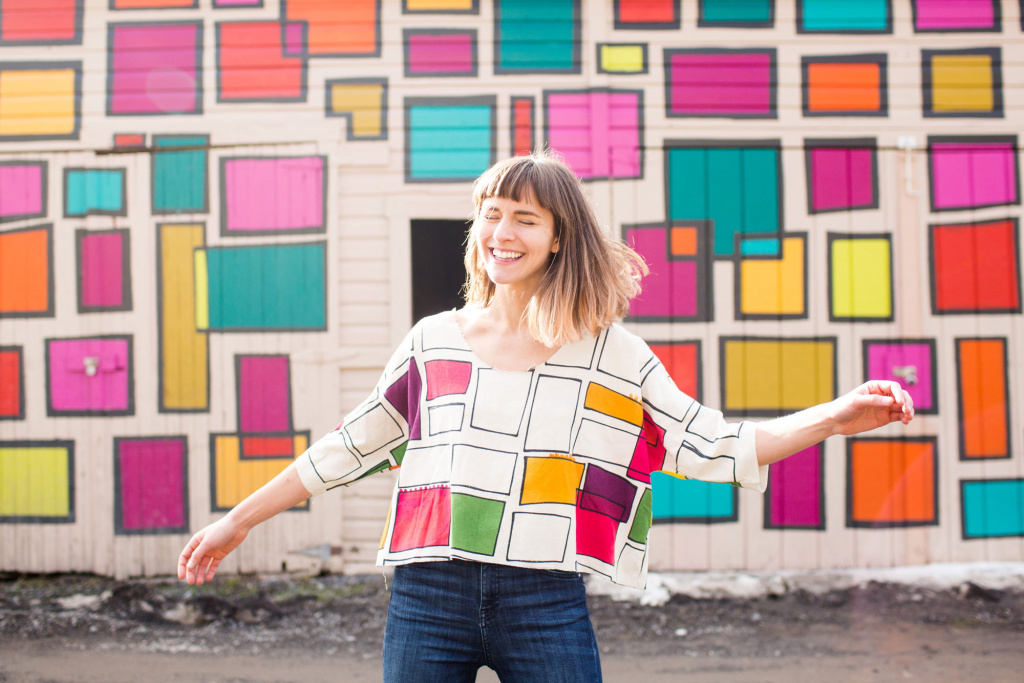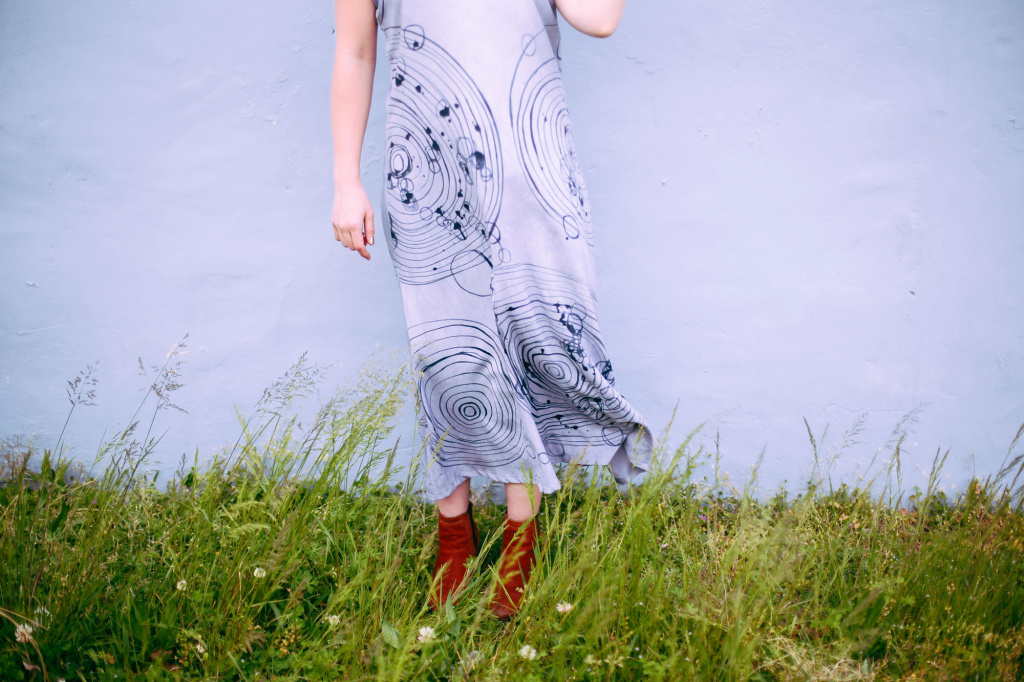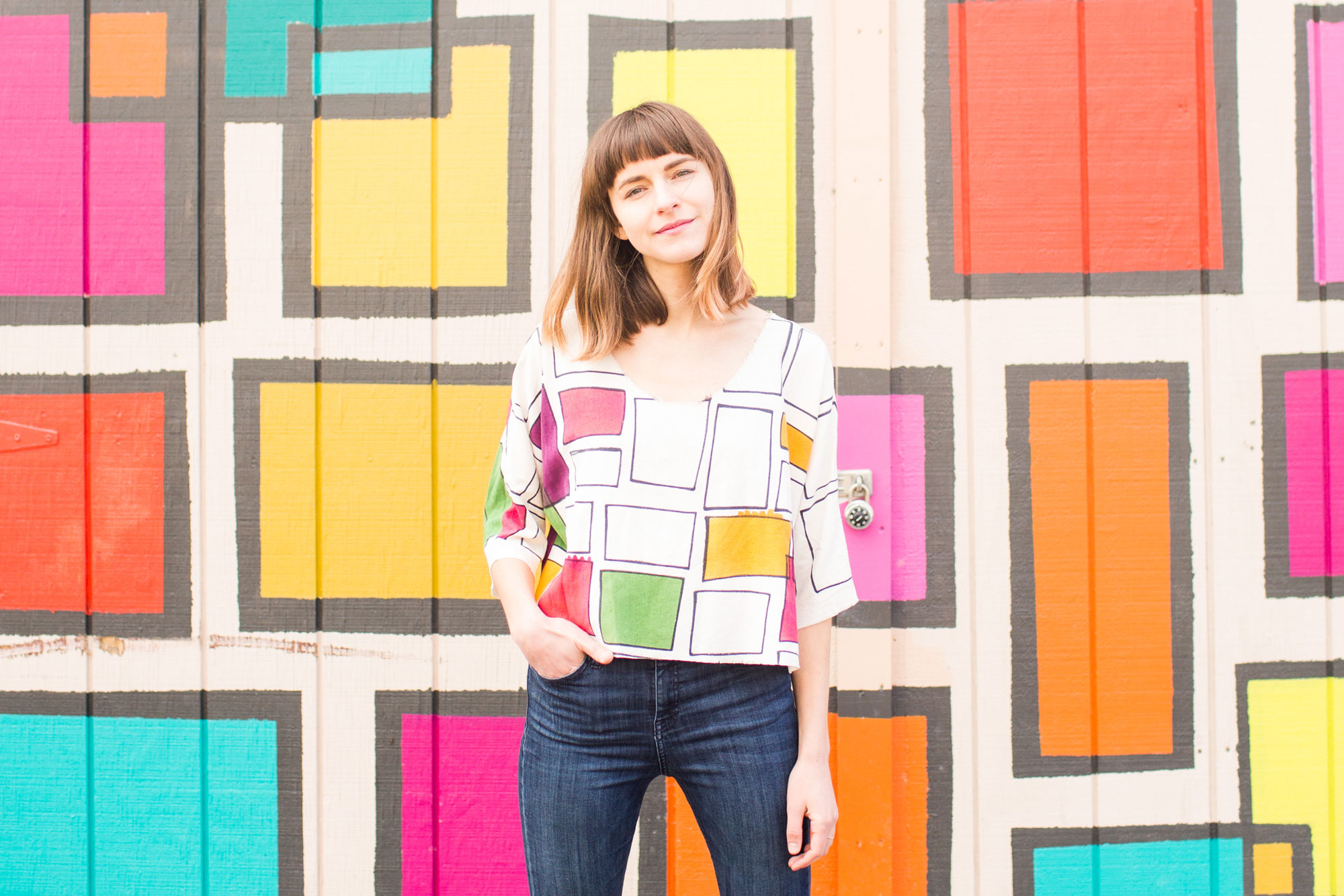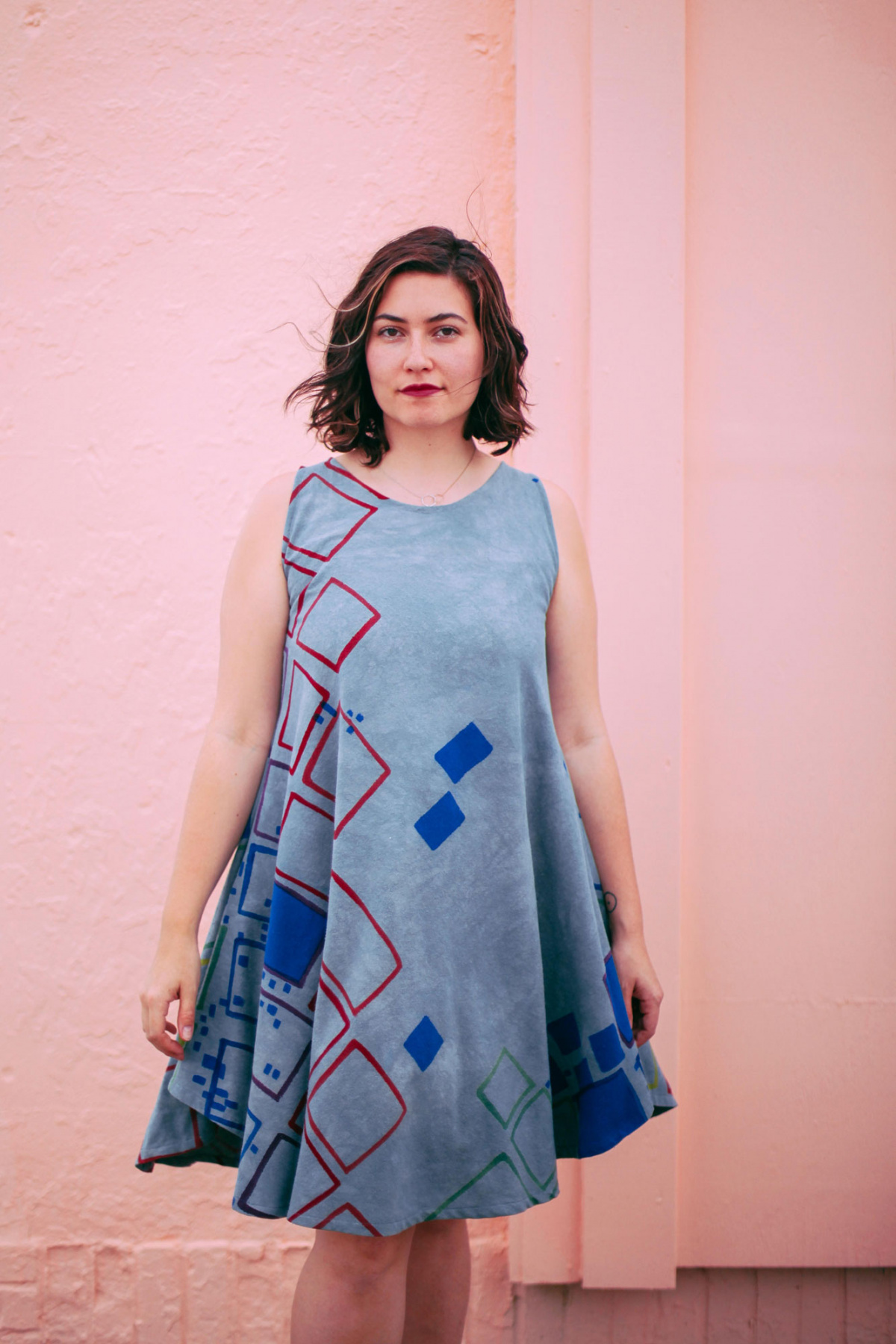Colorful squares, cheerfully blue asteroids, a splash of confetti and limes; artist Nellie Rose Davis spends much of her time hand-painting whimsical apparel. Each garment from Nellie Rose Textiles is one of a kind and takes up to two weeks to make.
Nellie Rose makes her home in the tiny West Virginia town of Thomas (population 562) on the edge of the Monongahela National Forest, where she runs her studio and collaborates with other artists as part of Lamplight Gallery on the main drag—the only drag—in town. Her parents, also artists, moved to the area during the “back-to-the-land” movement of the ’70s. “They designed, cut, dyed, and sewed silk to make exquisite collections of clothing, while us kiddos, ironically, ran around naked,” she laughs.
RELATED | Allie Kushnir on Her Low-Impact, High-Design Textiles & Paper Craft
How She Got Here
Nellie Rose spent two years studying in Japan, initially as a Fulbright Scholar in 2011 and then as an apprentice under an artist she’d long admired, Hiroko Harada, a shibori master and one of few people she named in her Fulbright proposal. While her Fulbright studies focused on traditional and contemporary surface design with lots of dye work, only about a week of her formal teaching centered on shibori, the traditional Japanese dyeing method she uses now to make pleated scarves. She learned the Japanese art was mostly passed down through families and, wanting to know more, reached out to Hiroko, who ultimately became one of her biggest mentors.
Nellie Rose’s parents have practiced shibori for decades. She remembers when they took a trip to Japan to attend a shibori symposium in Aichi Prefecture when she was very young, when her mother came back gushing about Hiroko’s work, saying the town was draped in it. The world being small, her mother later ran into a woman who worked on a book with Hiroko—and it eventually become one of Nellie Rose’s favorites. “I’ve had that book on my bookshelf since I was a kid.”

Nellie Rose is part of a growing group of artists transforming a small town. She recently wrote a proposal for this mural on an old shed that was funded by a public grant.
One of the biggest lessons Hiroko taught Nellie Rose was around tradition and allowing it to evolve. “In order for tradition to continue into the present it must be made relevant for the present and the future,” she says. It’s a lesson that sticks with her no matter what she’s working on. “Is this relevant to me? Is this relevant for the future?” she asks. It’s part of why she’s decided to phase out her shibori work and focus on her colorful clothing line. “Where I see Nellie coming through is through my clothing; I want the opportunity to work on it full-time.”
But Why Hand-Paint?
“It sounds cheesy, but there’s no other way for me to express what I want to express,” she says. “It’s strange. I don’t know if I can take all the credit for what comes out because it’s kind of like my meditation.”
Nellie Rose started hand-painting when she was restless and working only on shibori. “I ran to the local frame shop and said, ‘Can you build me this wooden thing that’s the width of my fabric?’ They put together scraps and made me this huge wooden frame so I could stretch my fabric on it. I threw dye at it and painted with any type of paintbrush I could find,” she says. “I never had this solidified picture in my head. I mostly had colors I thought would look wonderful together. It’s been such a primal, childlike experience. It satisfies a lot in me.”
“I’m creating paintings that then can be worn.”
Today her creations are equal parts eclectic and fine. While the pattern is never the same, each piece is full of life. “It’s like I’m creating paintings that then can be worn.” Nellie Rose hand-paints her designs on her yardage before cutting up the fabric and transforming it into clothing. This past winter she started to create a silkscreen studio to convert some of her hand-painted patterns. She still hand-paints the screen so garments have that same handcrafted feel, but she hopes this addition will ease some of the labor while allowing her to create a bit more. “Everything is so slow now because I’m starting from the actual surface design for the clothing. I realized within a year I can’t make as much as everyone else because I’m starting a step behind essentially—even though it’s my favorite step.”
Catching a Break
Nellie Rose was working in Virginia creating her shibori line when she traveled to a West Virginia arts festival and a woman from a prestigious art foundation in the region noticed her work. Soon she was living back in West Virginia and working as part of the Rural to Urban Markets program, a three-year program that allowed her to sell at wholesale markets. “I had just registered Nellie Rose Textiles and moved back to Elkins where I’m from (an hour’s drive from Thomas) and got to share my dad’s studio,” she says, adding that low overhead is crucial for any new artist. She credits her current success to that three-year program. “I wouldn’t have figured out how to live rurally while meeting an urban audience, which is who supported my work mostly at that time.”
Small-Town Support
At the same time, Nellie Rose found herself driving to Thomas often. “I fell completely in love with this area and the people who choose to spend time here. The spirit here is so entrepreneurial,” she says. “I’m surrounded, encouraged, pushed, and inspired by my contemporaries—folks doing and making such incredible contemporary, relevant artwork.” On one street in Thomas, young artists create sculptures, illustrations, leather work, photography, paintings, and more, all at a high quality.
Nellie Rose says she also feels fulfilled socially, as the area is increasingly a center of activity for creative types who value solitude. You’ll find breweries, a cocktail bar, art galleries, and offbeat shops all just minutes from opportunities to hike, ski, or sightsee. There’s also a popular small music venue, Purple Fiddle, with music almost every night of the week. People in Thomas show up, too, whether it’s a poetry reading, film screening, or local burger night. “That’s really cool,” she says. “The kind of tourism I believe we’re making is the type people like to return to. They want to keep coming back to see the evolution. They support it with their actions or their money. They want a little slice of this.”

But Thomas also gives her the space she needs to be an introvert. Not only can she afford to own her own home and studio, she can hide away and work as much as she needs. And her work is well received locally, even if the price tag starts at $110 for a top. “What I have found is not all my work has to be exported to urban areas,” she says. “A lot of my work comes directly to me through Lamplight. The gallery is supported I’d say half by locals and half by people visiting, which I think is really cool. You need to have a balance to make it sustainable.”
Last summer, Nellie Rose painted the first mural in town, on a shed off of a little alleyway she’s driven by for years. Today it serves almost as a beacon, pointing folks to that hidden part of town—East Avenue, aka Front Street—that they’d easily miss if they didn’t turn off. “I’ve encountered people who came around to see what was on the other side because they saw that mural. That’s the hope—just to breathe a little color into town.” It’s also something Nellie Rose says she’s happy to provide that’s free. “My clothing people have to spend money on, and it’s not cheap. What I really love about a mural—and what I love when I go to cities and soak up other murals, too—is it’s something you don’t have to pay for. It’s open to everybody.”
Photos by Kelsey McNair
This article originally appeared in the Fall/Winter 2018 issue of Sixtysix. Subscribe today.





